| Srl | Item |
| 1 |
ID:
085333
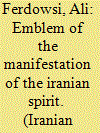

|
|
|
|
|
| Publication |
2008.
|
| Summary/Abstract |
This is a study of the national sacralization of Hafiz as the "emblem of the manifestation of the Iranian spirit." This sacralization began with E. G. Browne in 1902 but reached its definitive formulation in Abd al-Hosein Hazhir's monograph Hafiz-tashrih in 1928. For a nation to have a purchase on itself it must provide for a convocational experience. Shortly after the 1906 Constitutional Revolution, an ascending intellectual elite in Iran set out to do just that by fashioning a heterodox cult of the veneration of Persian poetry by recasting pre-modern texts, authors and their tombs into a national scripture authored by national prophets buried in sacred grounds which culminated in Hafiz as the "seal of its prophets."
|
|
|
|
|
|
|
|
|
|
|
|
|
|
|
|
| 2 |
ID:
044146
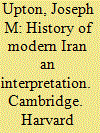

|
|
|
|
|
| Publication |
Cambridge, Harvard University Press, 1965.
|
| Description |
vi, 164p. pbk
|
|
|
|
|
|
|
|
|
|
|
|
Copies: C:1/I:0,R:0,Q:0
Circulation
| Accession# | Call# | Current Location | Status | Policy | Location |
| 000533 | 955.052/UPT 000533 | Main | On Shelf | General | |
|
|
|
|
| 3 |
ID:
110881
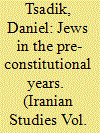

|
|
|
|
|
| Publication |
2010.
|
| Summary/Abstract |
During the Constitutional years (1906-11) the legal status of the Jews and some other religious minorities improved, even if only to a limited extent. Can one assume that this change in the legal status of the Jews reflected changes in the public's actual treatment toward the Jews in reality during the days leading up to the Constitutional Revolution in 1906? To an extent, the answer is in the affirmative. The present article argues, however, that the real life situation of the Jews in the years leading up to the Constitutional Revolution was still often one of abuse and occasional persecution. To prove this contention, section I of the article presents some such cases. Section II establishes some of the reasons for the attacks on the Jews-not only religious, but also economic and socio-political ones, as well as briefly suggesting certain recurring paradigms surrounding it. Section III looks at one case study from November 1905 in the city of Shiraz. Finally, this preliminary research ends with some concluding remarks.
|
|
|
|
|
|
|
|
|
|
|
|
|
|
|
|
| 4 |
ID:
109136
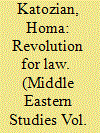

|
|
|
| 5 |
ID:
046553
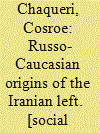

|
|
|
|
|
| Publication |
Richmond, Curzon Press, 2001.
|
| Description |
352p.hbk
|
| Series |
Caucasus World
|
| Standard Number |
0700714073
|
|
|
|
|
|
|
|
|
|
|
|
Copies: C:1/I:0,R:0,Q:0
Circulation
| Accession# | Call# | Current Location | Status | Policy | Location |
| 045022 | 955/CHA 045022 | Main | On Shelf | General | |
|
|
|
|
| 6 |
ID:
192271
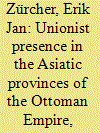

|
|
|
|
|
| Summary/Abstract |
This article investigates the way the Young Turk Committee of Union and Progress, which was essentially an organisation with roots in the European provinces of the Ottoman Empire and in the Western Anatolian province of Aydın, established itself in the provincial centres of Eastern Anatolia and the Arab provinces after the revolution of July 1908. It then seeks out the patterns that can be discerned in the composition of the local branches, and in the relationships of these branches with the committee’s centre (first in Salonica, then in Constantinople) on the one hand, and with the local Muslim elites and non-Muslim communities on the other.
|
|
|
|
|
|
|
|
|
|
|
|
|
|
|
|